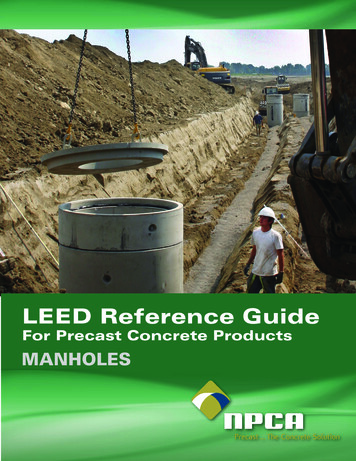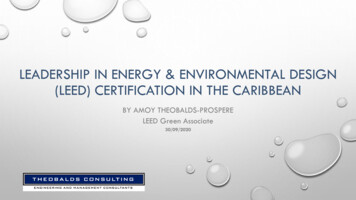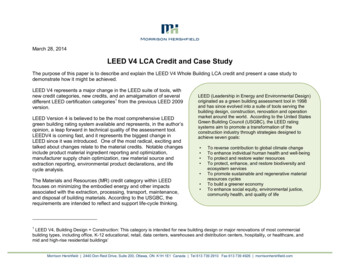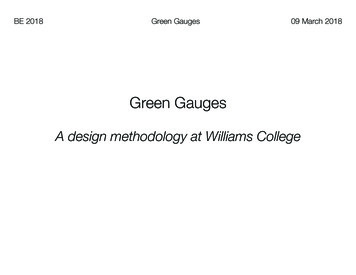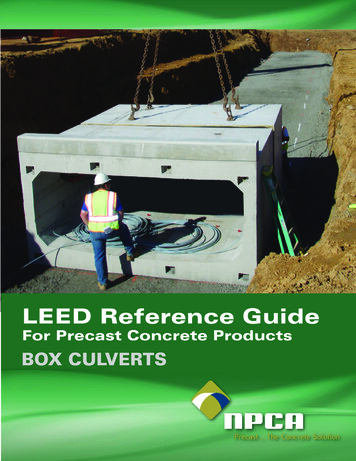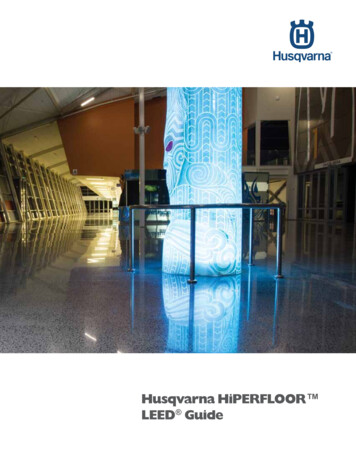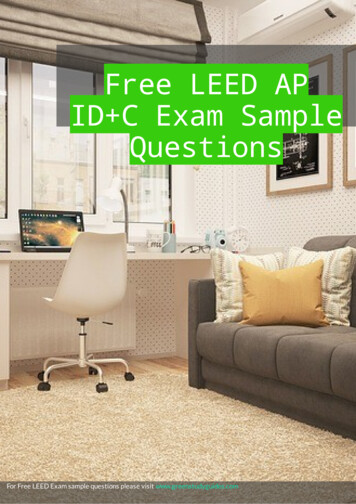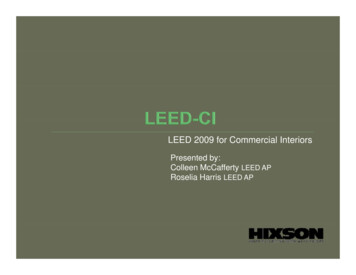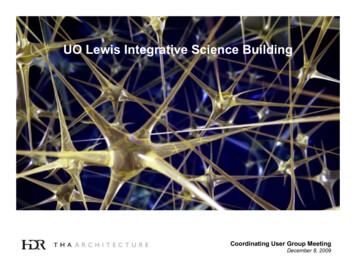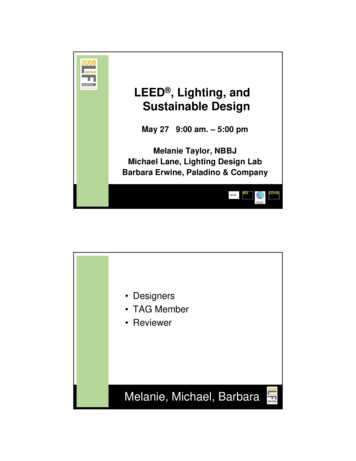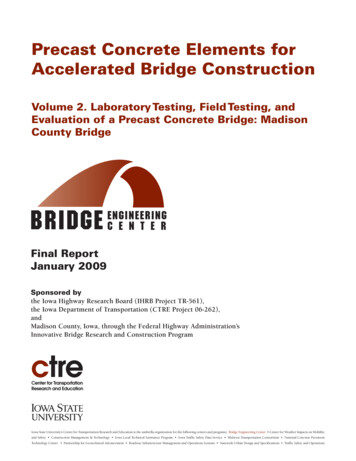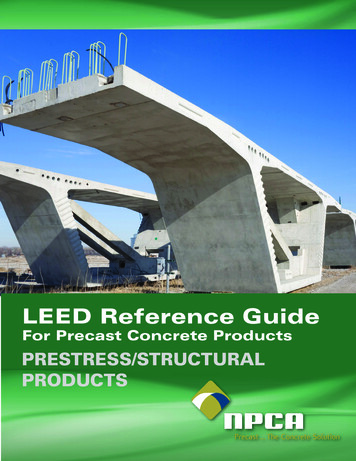
Transcription
LEED Reference GuideFor Precast Concrete ProductsPRESTRESS/STRUCTURALPRODUCTS
PRESTRESS/STRUCTURAL PRODUCTSLEED 2009 New Construction SS 5.1 – Site Development: Protect or Restore Habitat . . . 3 SS 5.2 – Site Development: Maximize Open Space. 4 IEQ 4.3 – Low Emitting Materials: Flooring Systems. 5 MR 4 – Recycled Content . 6 MR 5 – Regional Materials . . 7LEED 2008 Homes MR 1.5 – Material Efficient Framing: Off-Site Fabrication. 8 MR 2.2 – Environmentally Preferable Products. 9 MR 3 – Waste Management. 10 MR 5 – Regional Materials.11LEED 2009 Neighborhood Development GIB 7 – Minimized Site Disturbance in Design and Construction. 12 GIB 15 – Recycled Content in Infrastructure. 13National Precast Concrete Association1320 City Center Dr. Suite 200, Carmel, IN 46032(800) 366-7731 www.precast.orgThis publication is designed to provide accurate and authoritative information in regard to the subject matter covered; however, National PrecastConcrete Association acts as a mediator without approving, disapproving or guaranteeing the validity or accuracy of any data, claim or opinion appearingherein. Information is provided and disseminated with the understanding that the National Precast Concrete Association is not engaged in renderingengineering, legal or any other professional services. If engineering, legal or other professional assistance is required, the services of a competentprofessional should be obtained. The National Precast Concrete Association does not assume and hereby disclaims liability to any person for any loss ordamage caused by errors or omissions in the material contained herein, regardless of whether such errors result from negligence, accident or any othercause whatsoever.The Credit Requirements listed in this document are contained within the Leadership in Energy and Environmental Design Green Building RatingSystem developed by the United States Green Building Council. For more information on the LEED Green Building Rating System, please visit www.usgbc.org.For additional information about using precast concrete within the LEED system, please visit www.precast.orgLEED Reference Guide for Precast Concrete Products www.precast.org2
PRESTRESS/STRUCTURAL PRODUCTSPRESTRESS/STRUCTURALLEED New ConstructionSS 5.1Sustainable SitesSite Development –Protect or Restore HabitatCredit RequirementMax. Points: 1Site Development – Protect or RestoreHabitatCase 1 – Greenfield SitesLimit all site disturbances to the following parameters: 40 feet beyond the building perimeter 10 feet beyond surface walkways, patios, surface parking andutilities less than 12 inches in diameter 15 feet beyond primary roadway curbs and main utility branchtrenches 25 feet beyond constructed areas with permeable surfaces(such as pervious paving areas, stormwater detentionfacilities and playing fields) that require additional stagingareas to limit compaction in the constructed area, orCase 2 – Previously Developed AreasRestore or protect a minimum or 50% of the site (excluding thebuilding footprint) or 20% of the total site area (including buildingfootprint area), whichever is greater, with native or adaptedvegetation.Precast ContributionPrecast concrete products are castand cured in the plant and deliveredto the site ready to set. The impact onthe construction site is significantlyreduced because there is no formwork,less construction waste, less noise andfewer laborers needed on-site.Precast components also make it easierto fit into tight spaces with a minimumof site disturbance and shorterintallation times.In addition, precast products can becustom-built to nearly any specification.Because the products are ready toinstall, they can be staged off-site anddelivered on a schedule that keepsimpact to the site at a minimum.See the LEED Canada guide for information on Canada’s creditrequirements.LEED Reference Guide for Precast Concrete Products www.precast.org3
PRESTRESS/STRUCTURAL PRODUCTSPRESTRESS/STRUCTURALLEED New ConstructionSS 5.2Sustainable SitesSite Development –Maximize Open SpaceCredit RequirementMax. Points: 1Site Development – Maximize Open SpaceCase 1: Sites with Local Zoning Open Space RequirementsReduce the footprint and/or provide vegetated open space withinthe project boundary such that the amount of open space exceedslocal zoning requirements by 25%.Case 2: Sites with No Local Zoning Requirements (such assome university campuses, military bases)Provide a vegetated open space area adjacent to the building thatis equal in area to the building footprint.Precast ContributionPrecast concrete structural productscan help maximize open space whenused in parking garage structures. Theseprecast components can help reducethe overall footprint required for pavedparking, allowing for more vegetatedopen space.Case 3: Sites with Zoning Ordinances by No Open SpaceProvided vegetated open space equal to 20% of the project sitearea.ALL CASESFor projects in areas that earn SS Credit 2: Development Densityand Community Connectivity, vegetated roof areas can contributeto credit compliance.For projects in urban areas that earn SS Credit 2: DevelopmentDensity and Community Connectivity, pedestrian-orientedhardscape areas can contribute to credit compliance. For suchprojects, a minimum of 25% of the open space counted must bevegetated.Wetlands or naturally designated ponds may count as open spaceand the side slope gradients average 1:4 (vertical: horizontal) orless and are vegetated.LEED Reference Guide for Precast Concrete Products www.precast.org4
PRESTRESS/STRUCTURAL PRODUCTSCredit RequirementMax. Points: 1Option 1All flooring must comply with the following as applicable to theproject scope: All carpet installed in the building interior must meet the testingand product requirements o of the Carpet and Rug Institute GreenLabel Plus program. All carpet cushion installed in the building interior must meetthe requirements of the Carpet and Rug Institute Green Labelprogram. All carpet adhesive must meet the requirements of IEQ Credit4.1: Adhesives and Sealants, which includes a volatile organiccompound (VOC) limit of 50 g/L. All hard surface flooring must be certified as compliant withthe FloorScore2 standard (current as of this date of this ratingsystem), or more stringent version by an independent third party.Flooring products covered by FloorScore include vinyl, linoleum,laminate flooring, wood flooring, ceramic flooring, rubber flooringand wall base. An alternative compliance path using FloorScore is acceptablefor credit achievement: 100% of the non-carpet finished flooringmust be FloorScore-certified and must constitute at least 25% ofthe finished floor area. Examples of unfinished flooring includefloors in mechanical rooms, electrical rooms and elevator servicerooms. Concrete, wood, bamboo and cork floor finishes such as sealer,stain and finish must meet the requirements of South Coast AirQuality Management District (SCAQMD) Rule 113, ArchitecturalCoatings, rules in effect on Jan. 1, 2004. Tile-setting adhesives and grout must meet SCAQMD Rule1168. VOC limits correspond to an effective date of July 1, 2005,and rule amendment date of Jan. 7, 2005.PRESTRESS/STRUCTURALLEED New ConstructionIEQ 4.3Indoor EnvironmentalQualityLow Emitting MaterialsFlooring SystemsPrecast ContributionPrecast concrete prestressed/structuralproducts such as double tees, wallpanels, hollow core slabs, flat slabsand I-beam girders can contributetoward this credit, because precastconcrete does not emit Volatile OrganicCompounds (VOCs).Any sealers, stains or finishes mustmeet the South Coast Air QualityManagement District’s Rule 1113 onArchitectural Coatings.Architectural precast tiles and pavers canalso contribute toward this credit whensetting with adhesives and grouts thatmeet Rule 1168 on VOC limits.Option 2All flooring elements installed in the building interior must meetthe testing and product requirements of the California Departmentof Health Services Standard Practice for the Testing of VolatileOrganic Emissions from Various Sources Using Small-ScaleEnvironmental Chambers, including 2004 Addenda.LEED Reference Guide for Precast Concrete Products www.precast.org5
PRESTRESS/STRUCTURAL PRODUCTSPRESTRESS/STRUCTURALLEED New ConstructionMR 4Materials and ResourcesRecycled ContentPrecast ContributionPrecast concrete products may containsupplementary cementitious materialssuch as fly ash and blast furnace slagwhich will add to the project’s recycledcontent goals.Credit RequirementMax. Points: 2Recycled ContentRequirementsUse materials with recycled content such that the sum ofpostconsumer recycled content plus 1/2 the preconsumer contentconstitutes at least 10% or 20% (based on cost) of the total valueof the materials in the project. The minimum percentage materialsrecycled for each point threshold is:Recycled Content Points10%120%2The recycled content value of a material assembly is determinedby weight. The recycled fraction of the assembly is then multipliedby the cost of the assembly to determine the recycled contentvalue.Precast products may also contain rebarand welded wire mesh which is oftenmade from recycled steel.Other less frequently used recycledcontent components include variousfiber reinforcements, glass aggregates,silica fume, and recycled crushedconcrete.The NPCA LEED calculator helpsmembers respond with the properdocumentation required for this credit.Simply input the Zip Code/Postal Codeand weight for each component togenerate a pdf file that can be e-maileddirectly to the LEED AP, contractor orarchitect.Mechanical, electrical and plumbing components and specialtyitems such as elevators cannot be included in this calculation.Include only materials permanently installed in the project.Furniture may be included if it is included consistently in MRCredit 3: Materials Reuse through MR Credit 7: Certified Wood.LEED Reference Guide for Precast Concrete Products www.precast.org6
PRESTRESS/STRUCTURAL PRODUCTSPRESTRESS/STRUCTURALLEED New ConstructionMR 5Materials and ResourcesRegional MaterialsCredit RequirementMax. Points: 2Regional MaterialsUse materials or products that have been extracted, harvested,and manufactured within 500 miles of the project site.The calculation is based on the overall materials cost. Materialscosts include all expenses to deliver the material to theproject site. Materials costs should account for all taxes andtransportation costs incurred by the contractor but exclude anycost for labor and equipment once the material has been deliveredto the site.Regional Materials of 10% 1 pointRegional Materials of 20% 2 pointsSee the NPCA LEED Calculator at www.precast.org/leed for helpwith this credit.See the LEED Canada guide for information on Canada’s creditrequirements.Precast ContributionBecause concrete uses plentifuland natural raw materials, concretecomponents can be extracted,harvested and manufactured within 500miles of the project site. Using locallyobtained raw materials helps reducetransportation distances which reducesthe environmental impact of carbonemissions.If shipping is done by rail or water,LEED Canada allows up to 2,400km (1,500 miles) from both themanufacturing site to the projectsite and the location where buildingmaterials are extracted, harvested,recovered and processed to themanufacturing site.The NPCA LEED Calculator helpsprovide the proper documentationrequired for this credit. Simply inputthe Zip code where each raw materialoriginates and the weight of eachmaterial to generate a printable filethat can be e-mailed to the LEED AP,contractor or architect.LEED Reference Guide for Precast Concrete Products www.precast.org7
PRESTRESS/STRUCTURAL PRODUCTSPRESTRESS/STRUCTURALLEED HomesMR 1.5Materials and ResourcesMaterials-EfficientFraming –Off-Site FabricationCredit RequirementMax. Points: 4Material-Efficient Framing -- Off-siteFabricationUse either of the following alternatives to on-site framing:a) Panelized construction. Wall, roof and floor components aredelivered to the job site pre-formed.b) Modular, prefabricated construction. All principal buildingsections are delivered to the job site as prefabricatedmodules.For the complete credit, prerequisite and additional information,please visit www.usgbc.org to download the free LEED HomesGuide.Precast ContributionPrecast architectural wall panels andfoundations are panelized and createdat the plant, which helps create lessframing waste on the job site.In some cases, precast components caninclude the wall, roof and floor as onecomplete unit – ready to set and install –saving installation time and labor on thejob site.In addition, precast constructionreduces air leakage through fewer jointsand significantly decreases on-siteconstruction waste.LEED Reference Guide for Precast Concrete Products www.precast.org8
PRESTRESS/STRUCTURAL PRODUCTSPRESTRESS/STRUCTURALLEED HomesMR 2.2Materials and ResourcesEnvironmentallyPreferable ProductsPrecast ContributionCredit RequirementMax. Points: 4Environmentally Preferable Products(.5 point each, maximum 8 points)Use building component materials that meet one or more of thecriteria below: Environmentally preferable products. 0.5 points for usinga foundation with 30% fly ash/slag. An additional .5 point forexemplary performance of 50% flyash/slag, and/or Low Emissions (not applicable for concrete), and/or Local Production. 0.5 points for using a foundation that wasextracted, processed, and manufactured within 500 miles ofthe project site.Precast concrete products may containsupplementary cementitious materialssuch as fly ash and blast furnace slag,which will add to the project’s recycledcontent goals.Because concrete uses plentifuland natural raw materials, concretecomponents can be extracted,harvested and manufactured within 500miles of the project site. Using locallyobtained raw materials helps reducethe environmental impact of carbonemissions.The NPCA LEED calculator helpsmembers respond with the properdocumentation required for this credit.Simply input the Zip Code/Postal Codeand weight for each component togenerate a pdf file that can be e-maileddirectly to the LEED AP, contractor orarchitect.LEED Reference Guide for Precast Concrete Products www.precast.org9
PRESTRESS/STRUCTURAL PRODUCTSCredit RequirementMax. Points: 3PRESTRESS/STRUCTURALConstruction Waste Reduction3.1 Construction Waste Management Planning(Prerequisite)Investigate and document local options for diversion, thendocument the diversion rate for construction waste. (See LEEDHomes guide for full prerequisite)3.2 Construction Waste ReductionReduce or divert waste generated from new constructionactivities from landfills and incinerators to a level below theindustry norm. Use either of the two options:a) Reduced Construction Waste. Generate 2.5 pounds orless of net waste (not including waste diverted reclamationor recycling) per square foot of conditioned floor area. Usethe table to determine the score.b) Increased Waste Diversion. Divert 25% of more of thetotal materials taken off the construction site from landfillsand incinerators. Use the table to determine the score.Calculate the percentage using either weight or volume.AMOUNT TO LANDFILLS AND INCINERATORSReduced ConstructionWasteIncreased WasteDiversionLbs./Ft.2Cubic Yds./1,000 Ft.2% Waste% 5%38%50%63%75%88%0.00.0LEED HomesMR 3Materials and ResourcesWaste ManagementPrecast ContributionThis credit allows for 2.5 pounds ofconstruction waste per square footof floor space. Precast concrete cancontribute toward this credit because itis plant produced, which creates little tozero on-site construction waste.Less on-site waste means lesstransportation of waste, less cleanup time, and less time spent sortingrecyclables. These savings cancontribute to a quicker, cheaper projectand a more efficient constructionschedule.0.51.01.52.02.53.0LEED Reference Guide for Precast Concrete Products www.precast.org10
PRESTRESS/STRUCTURAL PRODUCTSPRESTRESS/STRUCTURALLEED HomesMR 5Materials and ResourcesRegional MaterialsCredit RequirementMax. Points: 2Regional MaterialsUse materials or products that have been extracted, harvested,and manufactured within 500 miles of the project site.The calculation is based on the overall materials cost. Materialscosts include all expenses to deliver the material to theproject site. Materials costs should account for all taxes andtransportation costs incurred by the contractor but exclude anycost for labor and equipment once the material has been deliveredto the site.Regional Materials of 10% 1 pointRegional Materials of 20% 2 pointsSee the NPCA LEED Calculator at www.precast.org/leed for helpwith this credit.See the LEED Canada guide for information on Canada’s creditrequirements.Precast ContributionBecause concrete uses plentifuland natural raw materials, concretecomponents can be extracted,harvested and manufactured within 500miles of the project site. Using locallyobtained raw materials helps reducetransportation distances which reducesthe environmental impact of carbonemissions.If shipping is done by rail or water, LEEDCanada allows up to 2,400 km (1,500miles) from both the manufacturingsite to the project site and the locationwhere building materials are extracted,harvested, recovered and processed tothe manufacturing site.The NPCA LEED Calculator helpsprovide the proper documentationrequired for this credit. Simply inputthe Zip code where each raw materialoriginates and the weight of eachmaterial to generate a printable filethat can be e-mailed to the LEED AP,contractor or architect.LEED Reference Guide for Precast Concrete Products www.precast.org11
PRESTRESS/STRUCTURAL PRODUCTSPRESTRESS/STRUCTURALLEED NeighborhoodDevelopmentGIB 7Green Infrastructureand BuildingsMinimized SiteDisturbance in Designand ConstructionCredit RequirementMax. Points: 1Minimized Site Disturbance in Designand ConstructionOption 1: Development Footprint on PreviouslyDeveloped Land:Locate 100% of the development footprint on areas previouslydeveloped, orOption 2: Undeveloped Portion of Project LeftUndisturbedLimit disturbance to: 40 feet beyond the building perimeter 10 feet beyond surface walkways, patios, surface parking andutilities less than 12 inches in diameter 15 feet beyond street curbs and main utility branch trenches 25 feet beyond constructed areas with permeable surfacesthat require additional staging areas to limit compaction in theconstructed zone.Precast ContributionPrecast concrete products are plantcast and delivered to the site ready toset so they reduce the staging arearequired which can reduce the overallsite disturbance.The impact on the construction siteis also reduced because there is noadditional formwork, which oftenrequires more construction area forabove-ground products and largerexcavation areas for undergroundproducts.Less impact on sites can reduceconstruction waste, shorten theconstruction schedule and require fewerlaborers on-site.Note: This is a condensed version of the credit. The full creditmay be downloaded from USGBC’s Neighborhood DevelopmentGuide.LEED Reference Guide for Precast Concrete Products www.precast.org12
PRESTRESS/STRUCTURAL PRODUCTSPRESTRESS/STRUCTURALLEED NeighborhoodDevelopmentGIB 15Green Infrastructureand BuildingsRecycled Content inInfrastructureCredit RequirementMax. Points: 1Recycled Content in InfrastructureUse materials for new infrastructure such that the sum ofpostconsumer recycled content, in-place reclaimed materials andone-half of the preconsumer recycled content constitutes at least50% of the total mass of infrastructure materials.Count materials in all of the following infrastructure items asapplicable to the project: Roadways, parking lots, sidewalks, unit paving, and curbs Water retention tanks and vaults Base and subbase materials for the above Stormwater, sanitary sewer, energy distribution, and waterpipingSee the NPCA LEED Calculator at www.precast.org/leed for helpwith this credit.See the LEED Canada guide for information on Canada’s creditrequirements.Precast ContributionPrecast concrete products may containsupplementary cementitious materialssuch as fly ash and blast furnace slagwhich will add to the project’s recycledcontent goals.Precast products may also containrebar and welded wire mesh whichcontains recycled steel. Other lessfrequently used recycled contentcomponents include various fiberreinforcements, glass aggregates, silicafume, and recycled crushed concrete.Beyond precast products themselves,recycled crushed concrete can alsocontribute to this credit when utilizedas road fill base.LEED Reference Guide for Precast Concrete Products www.precast.org13
LEED Reference Guide for Precast Concrete Products www.precast.org Credit Requirement Max. Points: 1 Precast Contribution PRESTRESS/ STRUCTURAL LEED New Construction SS 5.1 Sustainable Sites Site Development – Protect or Restore Habitat Site Developme
